Destructor was a 1880 Spanish warship designed by Fernando Villaamil as a fast ocean-going torpedo gunboat. She is often referred in publications as the main precursor of the destroyer type. Even the name is appropriate. Her role was clear when she was commissioned, however, despite being commissioned by the Minister of the Navy, Vice-Admiral Manuel Pezuela, no other sister ship was ordered afterwards, and Britain started to built its own “torpedo boats destroyers” almost a decade later, showing that she might be an influence, but not a clear starting point. In many ways, she is comparable with V. Cuniberti’s monocaliber designs at the turn of the century, albeit never built. The main reason was her gunboat nature, instead of a stretched, heavily armed torpedo boat.
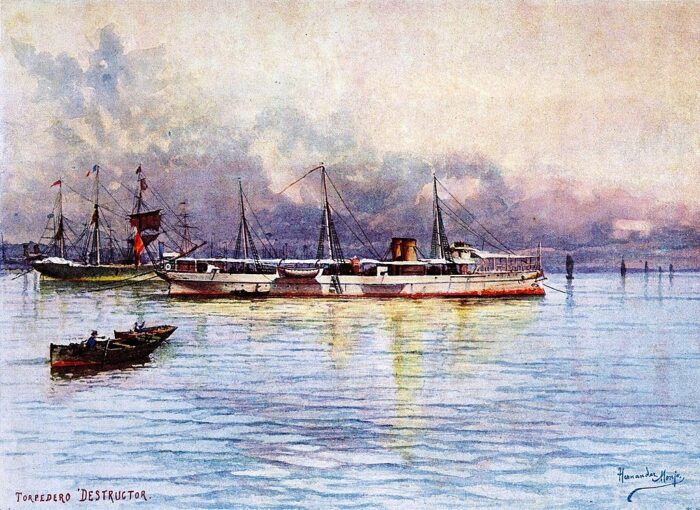
Development
The appearance of the “locomotive torpedo” in 1870 was a game changer. It was not obvious at first, but by gradually replacing the older spar torpedo, exposing its carrier to untold danger (as shown in the American civil war), the new torpedo acquired quite quickly the fearsome reputation of a device that could potentially defeat a much larger ship. It might be said that in the 1880, ships were somewhat protected against grounding a the hull being punctured by a reef to some extent, with compartments and ways to deal with limited flooding, but not when a 100 kgs guncotton charge exploded.
The torpedo change naval warfare but introducing an element that can completely unbalance the fleet’s capabilities. Whatever the size of the opposing fleet, qualities of crews and of its ships, the torpedo was a great leveller. It was the birth of asymmetric warfare.
The new danger took hold with the first torpedo boats, and in the 1880s with the French Jeune Ecole, the new ship type even became a mantra. It was not long though, before scores of counter-measures were taken: At first these major navies tried to create new ships type to hunt them down, the “torpedo gunboats” (because they had some themselves), or “torpedo-cruisers”. But they were slow and unable to catch these TBs down. Next, it was decided to add quick-firing guns onboard all cruisers and especially battleships. It was also decided to rework passive protection under the waterline. And at last, for harbour attacks, it was decided to fit nets around the hulls of battleships while in anchorage, albeit this was a short-lived measure.
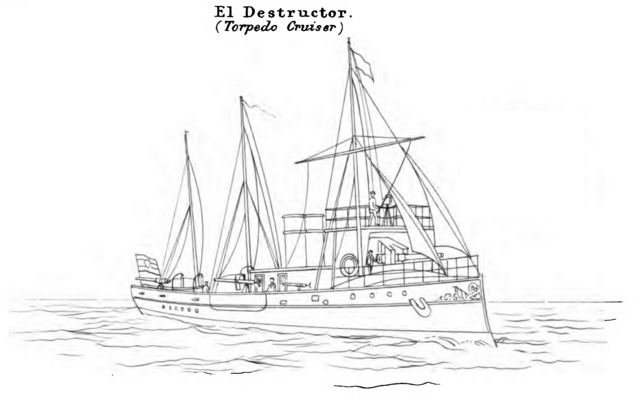
Spain had a sizeable navy before the war of 1898, inheriting many ironclads from the 1860s and adding new cruisers o the programme in the 1880s, mostly for colonial stations. But Spain also took interest in torpedo boats. In 1878 was built and accepted “Castor”, a 2nd class iron spar TB built at La Seyne. In 1879 this was “Pollux” at Yarrow, and in 1883 “Rigel” in Bremen, as a true TB for comparisons and experimentations. The came the two Acevedo class in 1885, Retamosa in 1885 (all UK) and Orion in Germany also in 1885, then the Barcezo, Habana, Azor, Ariete, Ejercito classes in 1886-87. The goal was to protect major Spanish ports.
Spain also planned a new type of escort vessel for close protection of its battleships, in particular its brand new “Pelayo”. Villaamil proposed a type of enlarged and fast torpedo boat with a range needed to protect battleships in long voyages but also able to attack themselves enemy battleships with torpedoes.
 Fernando Villaamil was a competent Spanish naval officer and engineer remembered as the designer of the Destructor. Born at Serantes, near Castropol (Asturias), north of Spain and of the Cantabrian coast, he descended from a noble family. However, when his father was ruined he joined the Armada in 1861, starting a midshipman at the Spanish Navy Colegio Naval de San Fernando. Gifted, her served in the Philippines and Cuba and by 1873 back in Spain her was nominated as teacher at the Naval School at Ferrol. Long story short, he did a national hero at the Battle of Santiago de Cuba, highest ranking Spanish officer killed that day commanding the destroyer “furor” (1896).
Fernando Villaamil was a competent Spanish naval officer and engineer remembered as the designer of the Destructor. Born at Serantes, near Castropol (Asturias), north of Spain and of the Cantabrian coast, he descended from a noble family. However, when his father was ruined he joined the Armada in 1861, starting a midshipman at the Spanish Navy Colegio Naval de San Fernando. Gifted, her served in the Philippines and Cuba and by 1873 back in Spain her was nominated as teacher at the Naval School at Ferrol. Long story short, he did a national hero at the Battle of Santiago de Cuba, highest ranking Spanish officer killed that day commanding the destroyer “furor” (1896).
Very aware of new developments in torpedo boats in 1885 he managed to convince the hthen Minister of the Navy, Vice-Admiral Manuel Pezuela, to ordered in Britain a new type of torpedo gunboat (the first in the Armada) that he would design. The tender was submitted to several British shipyards, which submitted proposals matching these specifications. In 1885 he selected James and George Thomson’s design (Clydebank), near the Yarrow shipyards and when funded, she was laid down at the end of the year. Destructor was named after her role, and she was launched on 29 July 1886, commissioned in early 1887. Still a small ships at 350 tonnes, she was nimble, narrow, with a well refined hull to make the best of her powerplant at the time, with a setup top speed of 23 knots, on par at the time to most TBs. She was well armed and agile.
Design of the class
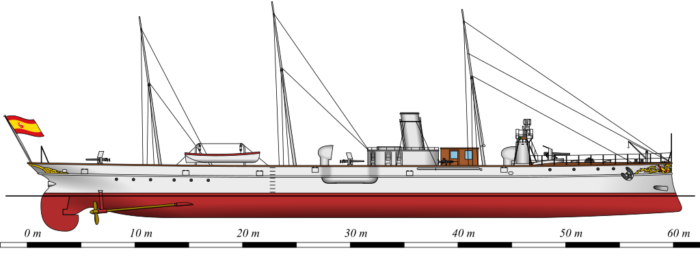
For gunnery, speed and dimensions her role was to hunt down and destroy torpedo boats. Generally the latter were deployed close to shore, but she was capable of high seas and to attack herself enemy ships if needed making her quite versatile. That’s why many authors consideres her as the first torpedo-boat destroyer ever built, notably well respected British naval engineer Sir William Henry White. Her construction in Britain did not went unnoticed. The RN also experimented with torpedo gunboats, and built a lot of them in the 1880s, but they were noticeably bulkier and slower.
Destructor by its qualities of speed and abilities combined with heavy quick firing armament clearly influenced the design and concept of later destroyers, notably in the Royal Navy. The approach was different as instead of another torpedo gunboat (recognised as a failure) in 1892 it was decided to simply stretched out an existing 1st class torpedo boat to create a “TB destroyer”. This led to the Havock class built in 1893. This came back in Spain which ordered its own Furor in 1896. The new nature of these ships was double, neutralized enemy TBs, keeping them away from the battle line, but also replaced them in the same role, but in high seas where their larger dimensions came in handy. She was classified as a “contratorpedero” which is identical to the French Contre Torpilleur (“counter”-TB) and roughly similar to the Italian cacciatorpediniere (TB hunter), what became later the classic “torpedo boat destroyer”, and simply the “destroyer”.
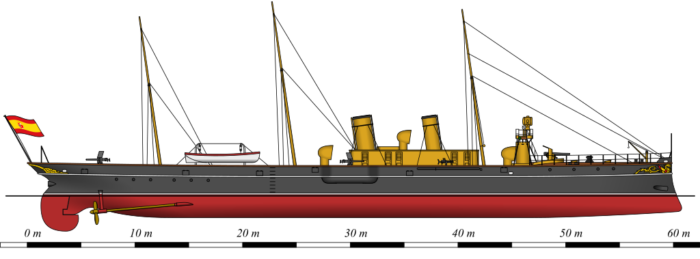
After refit with Normand boilers in 1897.
Hull and general design
Destructor displaced 348 long tons (354 t), she measured 58.74 m (192 ft 9 in) for a beam of 7.63 m (25 ft) giving her a ratio of 7.7. The draught was moderate but allowed good stability at 2.5 m (8 ft 2 in). She was able to navigate up rivers if needed. Design-wise, as completed she had a red hull below the waterline, white hull above, with a short ram bow, reinforced usable against a frail TBs, a decorated prow, a wooden foredeck with a turtle back, with her main gun in a recess, followed by a standing observation armoured conning tower protected from small arms fire supporting a flying bridge with chad burn and light projector. It was built so to give the commanding officer a towering view to command the ship. Protection was limited to three-quarter inch (18 mm) splinter plating over the machinery and on the conning tower.
Behind was a foremast, a small wooden bridge with the helmsman, and a small structure built around the single funnel, with accesses to the machinery below. There was one lighter gun on either beam in sponsons, and two aft, close to the poop. The whole main deck was wooden and bulwarked all the way to the poop. The latter was clipper style and well decorated. The funnel and all three masts were raked, and designed to carry a schooner rig if equipped for long crossings, but in practice, the ship never carried these. The crew was 60 strong, less than for a usual torpedo cruiser.
Powerplant
Destructor was equipped with triple-expansion engines. They were fed by four locomotive coal-fired rounded single hatch boilers, small and compact, yet powerful, just as on TBs of the time built in Britain. They were exhausted into two funnels side by side. In total these produced 3,784 horsepower (2,822 kW), for a maximum speed as designed of 22.6 knots (41.9 km/h). This made her one of the faster ships in the world in 1888. The record however did not hold long. She had two propeller shafts and small bronze three bladed propellers with struts and angled down considerably. The ship was very agile thanks to a generous rudder that protruded well below the keel. On her maiden voyage, she made a record steaming from Falmouth to Ferrol, in 24 hours, despite heavy seas.
Armament
She was armed with a single 90mm (3.5 in) Spanish Hontoria breech-loading gun forward under shield and four 57 mm (2.2 in) (6 pdr) Nordenfeldt guns, two in amidships sponsons, two paired aft close to the poop, also under light shields. This was completed by two 37 mm (1.46 in) Hotchkiss revolving cannons for close engagements, and two 15-inch (381 mm) torpedo tubes at the prow, close to the ram and over the waterline, pointing down. For these, the ship carried three Schwartzkopf torpedoes per tube.
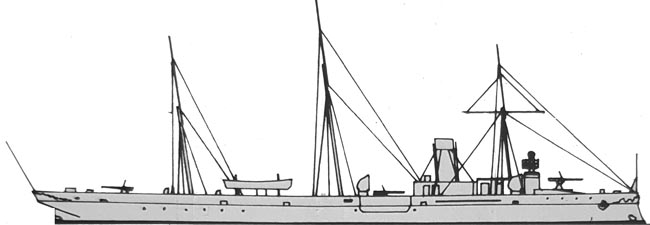
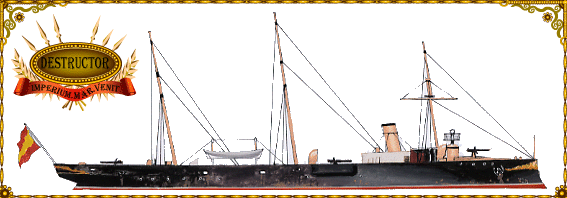
Author’s rendition
⚙ specifications |
|
| Displacement | 348 long tons (354 t) |
| Dimensions | 58.74 x 7.63 x 2.5 m (192 ft 9 in x 25 ft x 8 ft 2 in |
| Propulsion | TE engines 3,784 hp (2,822 kW) |
| Speed | 22.6 knots (26 mph; 41.9 km/h) |
| Range | 4,500 nmi (8,300 km) |
| Protection | 3/4 inches splinter plating abreast machinery, CT |
| Armament | 1× 90mm, 4 × 57mm, 2 × 37 mm, 2 × 360 mm (14 in) TTs |
| Crew | 60 |
Career of Destructor
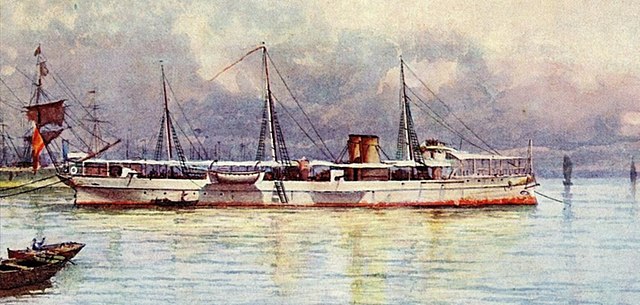
In 1884, Villaamil was appointed Second Officer in the Ministry of the Navy and took the initiative of studying and designing a new class intended to counter torpedo boats. He wrote an extensive report and sent its conclusions to the admiralty, which based on this agreed to finance an experimental ship. Minister of the Navy Manuel Pezuela agreed to submit the project to financing at the Cortes, and to select, once secured a shipyard, in that case, James & George Thompson, Clydebank with a swift construction starting in 1885.
J&G Thomson Clydebank shipyard was already asked to tender for TBDs for the Royal Navy and had a solid experience in much larger, but quite fast transatlantic liners and cruisers already. The experience was not lost when design first British navy TB destroyers in 1892, clearly a successor.
Villaamil in fact was assigned to the yard to supervise construction and also to study the operating procedures of the British naval dockyards with members of the new Engineers corps to modernized Ferrol’s own capabilities. On January 19, 1887 after successful yard trials, Destructor was formally handed over to the Spanish Navy and the new design was noticed by all, expecting news soon of its first trials and exercises.
On the 24th of January, she already reached 22.5 knots (41.7 km/h) on state trials before dropping anchor at Falmouth, and departing for Vigo, with Villaamil in command of the shop. 24 hours later without dropping below 18 knots (33 km/h) she had crossed the stormy Bay of Biscay without issue, demonstrating her seaworthiness and speed in heavy seas. When arriving, her designer and commander had every reason to feel proud, and his professional reputation grew in Spain and abroad. From Vigo, she sailed to the Bay of Cadiz (2 February 1887) and departed on 22 June for Cartagena.
On 16 July 1887 she was visited by the British squadron Commander in Cartagena, the Duke of Edinburgh, which at his request sailed at full speed and fired torpedoes.
Her first voyage across the Cantabrian Sea was to San Sebastian, in August 1887, boarded there by the Queen on August 22 with the Prime Minister and the Minister of the Navy, sailing to Cape Machichaco escorted by Lepanto and the steamer Ferrolano, with the Queen disembarking in Santander. She made another demonstration with the Queen on board Castilla and other officials. She carried out manoeuvres, fired salvos, launched torpedoes at pre-positioned targets and later remained in San Sebastián until 10 September as royal yacht, training with Ariete (1887) and alternating between there and Bilbao escorting Ferrolano. On 26 September she arrived Ferrol to repair a rudder failure, being dry-docked until March 1888. On April 5 she sailed to Cartagena with Halcón, Ariete, Rayo, Azor, Habana to meet up with other torpedo boats in Cartagena for exercises. While off Cape Finisterre they were caught by a strong storm and there was a boiler explosion on board Habana killing two stokers and two sailors. Adrift, she ran aground at Cape Toriñana and was towed out of danger by Destructor.
She also took part in other manoeuvers with Retamosa, Ordóñez, Acevedo and the cruisers Navarra, Castilla and ironclad Numancia in the Training Squadron under the director of the Cartagena Torpedo School, captain Don Segismundo Bermejo for seven weeks, trying out all sorts of tactics. It was interrupted when she was also prominently showcased at the Universal Exhibition in Barcelona in May and, at other occasions, boarded by the Queen Maria Cristina in Valencia for a squadron parade and sailing with the Torpedo Boat Division. Next she sailed to Valencia with the cruiser Isla de Cuba and Isla de Luzón, staying in Vigo, the summer of 1889. She also again acted as Royal yacht, sailing to San Sebastian and in Sept. hosting Juan Bautista Antequera. She was back in Ferrol on 15 October. Commander Villaamil was revieved by 1st class lt. Joaquín Barriere Pérez. In 1890 she was back to the Basque coast for the Royal Family. On 30 August she grounded and torn her rudder off Cape Machichaco while in a strong storm with the Minister of the Navy Jose Maria Beránguer on board to attend the launch of the armored cruiser Infanta Maria Teresa. She managed to reach Castro Urdiales and was towed to Bilbao for emergency repairs, completed in Ferrol late September and until April 1891.
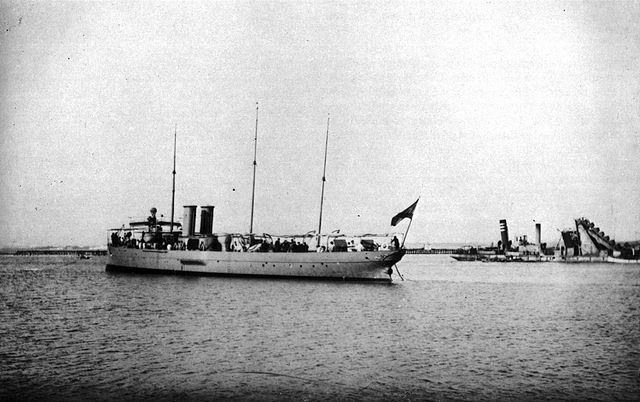
She was back with the Training Squadron (Rear Admiral Don Eduardo Butler) in Barcelona, escorting Pelayo, Reina Regente and Isla de Luzon off Cadiz. From Barcelona, they proceeded east, visited Greece, Rhodes, Jaffa, Alexandria and Malta and back on June 27. In 1891, she visited ports in the Cantabrian Sea and was decommissioned in Ferrol for 1892. In September 1893 she returned with the Training Squadron off Gata and San Antonio under Rear Admiral Don Zoilo Sánchez Ocaña, divided into “reds and blue” for a mock battle scenario off Alicante. She trained with Pelayo, Reina Mercedes, Isla de Cuba, Barceló, Rigel against Alfonso XII, Reina Regente, Ariete, Habana adn the gunboat Conde de Venadito. After refuelling at Cartagena she trained off the African coast.
In 1894, she was in La Carraca and was dry-docked to try to fix propulsion issues, as she could not pass 10 knots. In 1894, she took part in manoeuvres and remained from August 1894 to July 1895 inactive in Cartagena. By September from Ferrol she escorted the damaged Infanta María Teresa to Nervión shipyards. Next she left Ferrol with Almirante Oquendo for Cadiz and the Training Squadron.
In 1895, she was under command of 1st class lt. Emilio Guitart Savona and sailed for Cadiz, with the Training Squadron, then Cartagena after a stopover in Lisbon. She took part in manoeuvres in the Arosa estuary but was plagued by the poor condition of her machinery.
Near Cape Gata she had a rudder failure. She dropped anchor in Cartagena to fix it, sailed for Cadiz. The next day she entered the drydock at the La Carraca arsenal. Next she went to Melilla, Alhucemas, carrying the chief of staff of Melilla and returned to Cadiz with a new captain, Juan Iribarren Olazarra. By late January 1897, she sailed to Vigo, then Ferrol, and arrived in Glasgow to change her boilers. She had the new Normand type installed. When back to Ferrol she was capable of 22 knots, but most TBs and modern DDs were now around 33 knots. This new power plant also making for her new appearance with two unequal raked funnels in the centerline. Her hull was also painted black.
From August 1897 she had a dry-dock maintenance and sailed to Cadiz to join the Training Squadron under Segismundo Bermejo to patrol and trained off the Moroccan coast and dropped anchor in Tangier.
In 1898, during the Spanish-American War, she was assigned to the defense of the Cartagena naval base in the third division of torpedo boats, with Retamosa and Rigel. Thus happened after training with the Squadron commanded by Pascual Cervera y Topete, future admiral in Cuba. However, the manoeuvres were delayed as the minister came to realize the pitiful state of the ships, especially the artillery. After the manoeuvres were completed, the squadron entered Alicante and proceeded to Cartagena as tensions flared up in Cuba.
On March 29, 1898 Cervera’s squadron detailed to Cadiz, Alicante, Malaga, Algeciras adn Destructor with them arrived in Cadiz on the 6th under command of the 1st class lieutenant Rafael Carlier. She became flagship of the 3rd TB division, defending Cartagena. In May 1898 she was in Cadiz and later departed for Ceuta and back on January 1, 1899. By late July she was dry-docked at the La Carraca arsenal and returned for patrols to Morocco, notably carrying the correspondence of ambassadors, later under command of Francisco Barreda Miranda.
By October 1900, she had a refit at La Carraca and resumed patrols under Eduardo Bonmatí Ares. It was now clear that she was much slower than new destroyers, and was relegated as gunboat in southern Spain. From April 1903, Don Enrique Pérez Gros took command and her career was now mostly inactive. In April 1904 she joind the squadron commanded by Santaló to Cadiz in May for a visit of the King, which boarded her before being transferred to the yacht Giralda and escorted her for a cruise to Seville.
From Malaga she was in Tangier by late July 1904, at the orders of the Spanish consul, as tensions here rose. On November 6, 1905, under Antonio Romero Guerrero she returned to Cartagena with the Training Squadron (Rear Admiral Matta) which sorties to the Canary Islands, and she was sent to Melilla.
In April 1906 she made voyages between Melilla, Ceuta and Tangier, transporting Moroccan representatives and was stationed in Ceuta to protect Spanish fishermen from Moorish attacks. Last commander was José Butrón García. She took part in a landing with a battalion of Marines on board. Next she was relegated to escort and gunboat missions on the coast of North Africa, scheduled to be disarmed by May 1907. She was replaced on station by Numancia in Melilla by October 6, 1907, left for Tangier with General Marina and Staff on board, then Cadiz. She was decommissioned there on January 1, 1908. In 1911, she was auctioned for scrapping for 65,500 pesetas, her engines recycled to a land facility.
Read More/Src
Books
“Buques Viejos En Venta”. ABC (in Spanish) (1 ed.). Madrid, Spain. 5 December 1911.
VV.AA. (1981). El buque en la armada española. Sílex. p. pp. 320 y ss.
Atlas Ilustrado de la Marina Militar Española. Madrid: Susaeta. p. 151.
Fitzsimmons, Bernard: The Illustrated encyclopedia of 20th century weapons and warfare. Columbia House, 1978
Banbury, Philip (1971). Shipbuilders of the Thames and Medway. David and Charles, p. 300
Smith, Charles Edgar: A short history of naval and marine engineering. Babcock & Wilco University Press, 1937
The Mariner’s Mirror. Society for Nautical Research. 1984. p. 160.
Polmar, Norman; Cavas, Christopher (2009). Navy’s Most Wanted™, The Top 10.
Illustrated Naval and Military Magazine: A monthly journal devoted to all subjects connected with Her Majesty’s land and sea forces, 1888
“Under the influence of Fernando Villamil (1845–1898), Spain in 1886 produced the first torpedo boat destroyer.” Kern, Robert & Dodge, Meredith, Greenwood Press.
Carr Laughton, Leonard George; Anderson, Roger Charles and Perrin, William Gordon (1985). Mariner’s mirror: wherein may be discovered his art, craft & mystery after the manner of their use in all ages and among all nations. Vole 71. Society for Nautical Research.
Dolby, James: The Steel Navy: A History in Silhouette, 1860–1963. Macdonald, 1965
Chesneau, R & Kolesnik, E (Eds). Conway’s All the World’s Fighting Ships 1860–1905. 1979.
Lyon, David. The First Destroyers, Chatham Shipshape Series, London, 1997.
Links
on en.wikipedia.org/
on todoavante.es/
on abc.es/
hemeroteca.lavanguardia.com
Videos
Model Kits
None

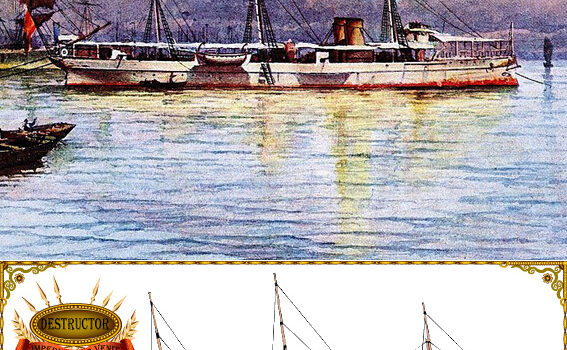

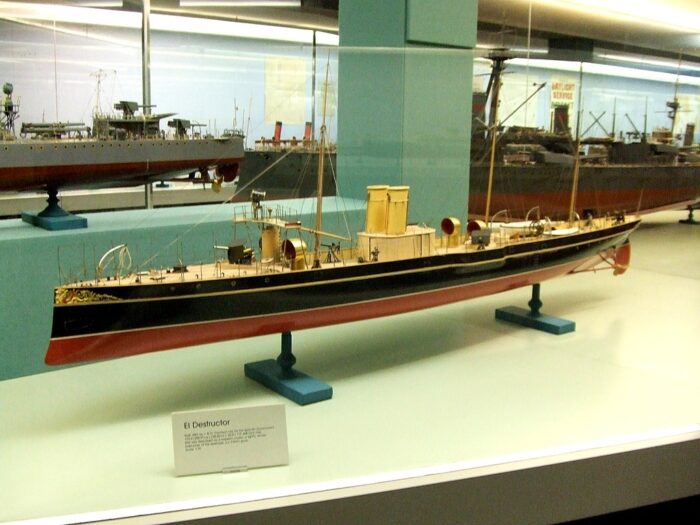
 Latest Facebook Entry -
Latest Facebook Entry -  X(Tweeter) Naval Encyclopedia's deck archive
X(Tweeter) Naval Encyclopedia's deck archive Instagram (@navalencyc)
Instagram (@navalencyc)





 French Navy
French Navy Royal Navy
Royal Navy Russian Navy
Russian Navy Armada Espanola
Armada Espanola Austrian Navy
Austrian Navy K.u.K. Kriegsmarine
K.u.K. Kriegsmarine Dansk Marine
Dansk Marine Nautiko Hellenon
Nautiko Hellenon Koninklije Marine 1870
Koninklije Marine 1870 Marinha do Brasil
Marinha do Brasil Osmanlı Donanması
Osmanlı Donanması Marina Do Peru
Marina Do Peru Marinha do Portugal
Marinha do Portugal Regia Marina 1870
Regia Marina 1870 Nihhon Kaigun 1870
Nihhon Kaigun 1870 Preußische Marine 1870
Preußische Marine 1870 Russkiy Flot 1870
Russkiy Flot 1870 Svenska marinen
Svenska marinen Søværnet
Søværnet Union Navy
Union Navy Confederate Navy
Confederate Navy Armada de Argentina
Armada de Argentina Imperial Chinese Navy
Imperial Chinese Navy Marinha do Portugal
Marinha do Portugal Mexico
Mexico Kaiserliche Marine
Kaiserliche Marine 1898 US Navy
1898 US Navy Sovietskiy Flot
Sovietskiy Flot Royal Canadian Navy
Royal Canadian Navy Royal Australian Navy
Royal Australian Navy RNZN Fleet
RNZN Fleet Chinese Navy 1937
Chinese Navy 1937 Kriegsmarine
Kriegsmarine Chilean Navy
Chilean Navy Danish Navy
Danish Navy Finnish Navy
Finnish Navy Hellenic Navy
Hellenic Navy Polish Navy
Polish Navy Romanian Navy
Romanian Navy Turkish Navy
Turkish Navy Royal Yugoslav Navy
Royal Yugoslav Navy Royal Thai Navy
Royal Thai Navy Minor Navies
Minor Navies Albania
Albania Austria
Austria Belgium
Belgium Columbia
Columbia Costa Rica
Costa Rica Cuba
Cuba Czechoslovakia
Czechoslovakia Dominican Republic
Dominican Republic Haiti
Haiti Hungary
Hungary Honduras
Honduras Estonia
Estonia Iceland
Iceland Eire
Eire Equador
Equador Iran
Iran Iraq
Iraq Latvia
Latvia Liberia
Liberia Lithuania
Lithuania Mandchukuo
Mandchukuo Morocco
Morocco Nicaragua
Nicaragua Persia
Persia San Salvador
San Salvador Sarawak
Sarawak Uruguay
Uruguay Venezuela
Venezuela Zanzibar
Zanzibar Warsaw Pact Navies
Warsaw Pact Navies Bulgaria
Bulgaria Hungary
Hungary

 Bundesmarine
Bundesmarine Dutch Navy
Dutch Navy Hellenic Navy
Hellenic Navy Marina Militare
Marina Militare Yugoslav Navy
Yugoslav Navy Chinese Navy
Chinese Navy Indian Navy
Indian Navy Indonesian Navy
Indonesian Navy JMSDF
JMSDF North Korean Navy
North Korean Navy Pakistani Navy
Pakistani Navy Philippines Navy
Philippines Navy ROKN
ROKN Rep. of Singapore Navy
Rep. of Singapore Navy Taiwanese Navy
Taiwanese Navy IDF Navy
IDF Navy Saudi Navy
Saudi Navy Royal New Zealand Navy
Royal New Zealand Navy Egyptian Navy
Egyptian Navy South African Navy
South African Navy






























 Ukrainian Navy
Ukrainian Navy dbodesign
dbodesign